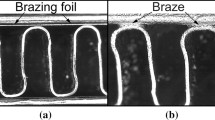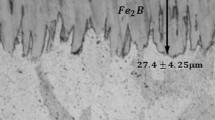Abstract
The tensile strengths, σSLJ, of 444 stainless steel single-lap joints (SLJs) brazed with two corrosion-resistant Ni-based braze filler metals (BFMs) were investigated and compared with results from joints made from 316L stainless steel using identical BFMs and processes. In previous work, we proposed that σSLJ could be understood in terms of SLJ geometry (primarily the ratio of overlap length o to plate thickness t—which determines the stress state), base metal properties (which determine stress state evolution with load), and braze microstructure (which determines local failure stress). The geometry and braze microstructure were varied in the prior work. The present study shows the effect of the base metal. 444 has higher yield stress, lower ultimate strength, and less strain hardening than 316L, and also experiences significant grain growth above 1100 °C. Although the braze microstructures of SLJs made using 444 are very similar to those of their 316L counterparts, not only σSLJ, but also variations of both σSLJ and failure mode with o/t are very different. Differences are not simply due to ultimate strength as is commonly assumed, but to how plasticity controls joint rotation and thus stress state during loading, as well as through-thickness grain boundaries acting as failure sites.











Similar content being viewed by others
References
D.J. Kemmenoe, E.A. Theisen, and S.P. Baker: Metall. Mater. Trans. A., 2021, vol. 52A, pp. 3317–41.
R.K. Shah: Heat Transf. Eng., 2006, vol. 27, pp. 3–22.
A. Rabinkin, E. Wenski, and A. Ribaudo: Weld. J., 1998, vol. 77, pp. 66S-75S.
T. Hartmann and M. Marsilius: In LÖT 11th Int. Conf. of Brazing, High Temperature Brazing, and Diffusion Bonding, (DVS 325: Aachen Germany, 2016), pp. 239–44.
T. Hartmann and D. Nuetzel: In LÖT 9th Int. Conf. of Brazing, High Temperature Brazing, and Diffusion Bonding, (DVS 263: Aachen Germany, 2010), pp. 42–47.
Y. Miyazawa, M. Ishihara, K. Ota, and Y. Bizen: In Int. Brazing and Soldering Conf., (AWS: Long Beach CA, 2015).
T. Grostad, L. Kjellen, and M. Stroiczek: In LÖT 12th Int. Conf. of Brazing, High Temperature Brazing, and Diffusion Bonding, (DVS 353: Aachen Germany, 2019), pp 324–35.
H. Li, X. Zhang, O. Mars, X. Zhao, Q. Lu, and Z. Chen: Weld. World., 2019, vol. 63, pp. 263–75.
D.Y. Park, S.K. Lee, and Y.J. Oh: Metall. Mater. Trans. A., 2018, vol. 49A, pp. 4684–99.
N.R. Philips, C.G. Levi, and A.G. Evans: Metall. Mater. Trans. A., 2008, vol. 39A, pp. 142–49.
J.P. James, F. Bocher, and J.R. Scully: Corrosion., 2009, vol. 65, pp. 511–26.
AWS C3.2 Standard Method for Evaluating the Strength of Brazed Joints, American Welding Society, Miami FL, 2019, pp. 1–17.
316/316L Stainless Steel Product Bulletin, AK Steel, West Chester, OH, 2016.
444 Stainless Steel Product Bulletin, AK Steel, West Chester, OH, 2018.
K.A. Cashell and N.R. Baddoo: Thin-Walled Struct., 2014, vol. 83, pp. 169–81.
M. Marsilius and T. Hartmann: In LÖT 11th Int. Conf. of Brazing, High Temperature Brazing, and Diffusion Bonding, (DVS 325: Aachen Germany, 2016), pp. 227–32.
C.C. Silva, J.P. Farias, H.C. Miranda, R.F. Guimaraes, J.W.A. Menezes, and M.A.M. Neto: Mater. Charact., 2008, vol. 59, pp. 528–33.
M. Goland and E. Reissner: J. Appl. Mech., 1944, vol. 11, pp. A17–A27.
B. Riggs, A. Benatar, B.T. Alexandrov, and R. Xu: Weld. J., 2017, vol. 96, pp. 421S-428S.
Y. Flom and L. Wang: Weld. J., 2004, 32S–38S.
J.P.M. Goncalves, M.F.S.F. de Moura, and P.M.S.F. de Castro: Int. J. Adhes. Adhes., 2002, vol. 22, pp. 357–65.
E. Sancaktar and P.O. Lawry: J. Adhes., 1980, vol. 11, pp. 233–41.
N.A. de Bruyne: Iron Age, 1944, pp. 60–63.
Brazing Technical Bulletin No. T-5 (Revised), Handy & Harman, New York, NY, 1989.
A.S. McLaren and I. MacInnes: Br. J. Appl. Phys., 1958, vol. 9, pp. 72–77.
G. Fessel, J.G. Broughton, N.A. Fellows, and J.F. Durodola: Int. J. Adhes. Adhes., 2007, vol. 27, pp. 574–83.
Acknowledgments
This work was supported by the National Science Foundation (IGERT-0966045, ENG-1400964) and the Metglas Hasegawa Fellowship at Cornell University.
Conflict of interest
One author (EAT) is employed by Metglas Inc., which provided a small portion of the funding for this work as well as samples.
Author information
Authors and Affiliations
Corresponding author
Additional information
Publisher's Note
Springer Nature remains neutral with regard to jurisdictional claims in published maps and institutional affiliations.
Rights and permissions
About this article
Cite this article
Kemmenoe, D.J., Theisen, E.A. & Baker, S.P. Strength of 444 Stainless Steel Single-Lap Joints Brazed with Ni-Based Metallic Glass Foils for Corrosive Environments. Metall Mater Trans A 53, 1407–1418 (2022). https://doi.org/10.1007/s11661-022-06601-9
Received:
Accepted:
Published:
Issue Date:
DOI: https://doi.org/10.1007/s11661-022-06601-9




